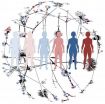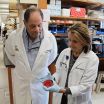(Press-News.org) A study by Curtin University researchers and colleagues from Denmark and New Zealand strengthens the case for human involvement in the disappearance of New Zealand's iconic megaherbivore, the moa - a distant relative of the Australian Emu.
All nine species of New Zealand moa, the largest weighing up to 250 kilograms, became extinct shortly after Polynesians arrived in the country in the late 13th century.
Researchers have previously suggested, from limited genetic evidence, that huge populations of moa had collapsed before people arrived and hence influences other than people were responsible for the extinction.
Writing in the Proceedings of the National Academy of Sciences, USA, the researchers analysed the gene pools of four moa species in the 5000 years preceding their sudden extinction using ancient DNA from more than 250 radiocarbon-dated moa.
The huge data sets provided an unprecedented level of insight into what was happening to the populations of an extinct megafauna, allowing a detailed examination of the extinction process.
The genetic study was led by Professor Mike Bunce from Curtin University's Department of Environment and Agriculture, situated in Perth, Western Australia.
"Characterising a people's interactions with the environment is a fundamental part of archaeological research – it has been portrayed anywhere on a scale from the harmonious to the catastrophic," Professor Bunce said
"Elsewhere the situation may be more complex, but in the case of New Zealand the evidence provided by ancient DNA is now clear: the megafaunal extinctions were the result of human factors.
"Lessons can certainly be learnt from the historical study of megafaunal extinctions. As a community we need to be more aware of the impacts we are having on the environment today and what we, as a species, are responsible for in the past."
Morten Allentoft, a PhD student in Professor Bunce's laboratory and now a Post-Doctoral Fellow at the Centre for GeoGenetics in the Natural History Museum in Copenhagen, performed the genetic work.
"There is nothing in our ancient DNA data that suggests that any of the four species moa was already on the way out when humans arrived," Dr Allentoft said.
"Our detailed genetic analyses, using variable nuclear markers similar to that used in forensic DNA profiling, show that moa gene pools were extremely stable throughout their last 5000 years.
"If anything it looks like their populations were increasing and viable when humans arrived. Then they just disappeared."
INFORMATION:
Professor Bunce and Dr Allentoft were joined in their research by Professor Richard Holdaway from the University of Canterbury in New Zealand and other co-authors.
Ancient DNA shows moa were fine until humans arrived
Curtin research gives new light to megafaunal extinctions in New Zealand
2014-03-19
ELSE PRESS RELEASES FROM THIS DATE:
No-refrigeration, spray vaccine could curb diseases in remote areas
2014-03-19
DALLAS, March 19, 2014 — A new kind of single-dose vaccine that comes in a nasal spray and doesn't require refrigeration could dramatically alter the public health landscape — get more people vaccinated around the world and address the looming threats of emerging and re-emerging diseases. Researchers presented the latest design and testing of these "nanovaccines" at the 247th National Meeting & Exposition of the American Chemical Society (ACS), the world's largest scientific society.
Their talk was one of more than 10,000 presentations at the meeting, being held here ...
Understanding binge eating and obesity
2014-03-19
VIDEO:
In this JoVE video article, a set of methods to measure food-related motivation and values are described in JoVE's peer-reviewed video article format.
Click here for more information.
March 19, 2014 —Researchers at the University of Cambridge have developed a novel method for evaluating the treatment of obesity-related food behavior. In an effort to further scientific understanding of the underlying problem, they have published the first peer-reviewed video of their technique ...
101 liver cancer drug candidates pave the way to personalized medicine
2014-03-19
The heart disease drug perhexiline is one of 101 compounds predicted to prevent cancer growth in most patients suffering from our most common liver cancer, HCC. This is an outcome from a novel simulation-based approach using personal sets of proteins of six HCC patients.
"This is the first time personalized models have been used to find and evaluate new potential drugs," says Professor Jens Nielsen at Chalmers University of Technology.
--
Our most common liver cancer, Hepatocellular carcinoma, HCC, causes more than half a million deaths worldwide every year. If the ...
Gut bacteria can cause life-threatening infections in preterm babies
2014-03-19
Babies born prematurely are surviving in increasing numbers. But many withstand complications of early birth only to suffer late-onset sepsis — life-threatening bloodstream infections that strike after infants reach 72 hours of age.
While early-onset sepsis often is caused by pathogens acquired from the amniotic sac or birth canal, the causes of late-onset sepsis have been far less clear.
But now, researchers at Washington University School of Medicine in St. Louis have discovered that preterm babies' guts harbor infectious microbes that can cause late-onset sepsis.
The ...
Drinking alcohol several times a week increases the risk of stroke mortality
2014-03-19
Consuming alcohol more frequently than twice a week increases the risk of stroke mortality in men, according to a study carried out at the University of Eastern Finland. The results show that the effects of alcohol are not limited to the amount consumed, but also the frequency of drinking matters. The results were published in Acta Neurologica Scandinavica on 8 March.
Excessive consumption of alcohol is associated with a variety of different diseases. The relationship between alcohol consumption and ischaemic stroke shows a J curve pattern, which means that in people ...
GPS also helps to analyze global water resources
2014-03-19
This news release is available in German. FRANKFURT. WaterGAP (Water Global Assessment and Prognosis) is a hydrological model used to model water shortage, groundwater depletion, and floods and droughts (e.g. as impacted by climate change) over the land area of the globe. The Frankfurt hydrologist Prof. Petra Döll has examined how good a fit this model provides, using GPS observations and data from the GRACE satellite, which measures the gravitational field of the Earth. The study, published in the current issue of the scientific journal Surveys in Geophysics indicates ...
Rewrite the textbooks on water's surface tension
2014-03-19
Researchers from the University of Melbourne and University of Sydney are confident their new reaserach results will make significant differences to the calculations of surface tension of water used by the next generation of atmospheric scientists, biophysicists and engineers of technology like inkjet printers.
These latest investigations have clinched a long-standing controversy amongst the physical Chemistry community; the air-water interface is negatively charged by the adsorption of hydroxide ions.
Prof Angus Gray-Weale from the Chemistry, Department of Chemistry ...
Ottawa researchers find new pathway connected to type 2 diabetes
2014-03-19
Ottawa, ON, March 19, 2014 — Scientists at the Children's Hospital of Eastern Ontario (CHEO) Research Institute have discovered a cellular pathway that is responsible for keeping blood sugar levels low in obese or pre-diabetic people, and may prevent the onset of Type 2 diabetes. The discovery published this month in a leading journal Nature Cell Biology.
Following a meal, beta cells found in islets of the pancreas secrete insulin that helps to store food energy for future use. The inability of islet beta cells to produce enough insulin leads to diabetes. Unlike other ...
Postoperative cognitive dysfunction
2014-03-19
Older persons, in particular, tend to suffer from memory lapses and other types of cognitive impairment after undergoing surgical procedures (postoperative cognitive dysfunction, POCD). Surgery has been performed on older patients much more commonly in recent years than ever before, and their pre- and postoperative care has become an important matter. Ingrid Rundshagen, an anesthesiologist, has surveyed the available literature to find out what kinds of patients are more likely to have cognitive impairment after surgery, and how the clinical manifestations should best be ...
Diversity in UK gardens aiding fight to save threatened bumblebees, study suggests
2014-03-19
The global diversity of plants being cultivated by Britain's gardeners is playing a key role in the fight to save the nation's threatened bumblebees, new research has revealed.
Ecologists at Plymouth University, in a study published this week, have shown the most common species of bumblebee are not fussy about a plant's origin when searching for nectar and pollen among the nation's urban gardens.
But other species – and, in particular, long-tongued bees – do concentrate their feeding upon plants from the UK and Europe, for which they have developed a preference evolved ...
LAST 30 PRESS RELEASES:
Scientists boost cell "powerhouses" to burn more calories
Automatic label checking: The missing step in making reliable medical AI
Low daily alcohol intake linked to 50% heightened mouth cancer risk in India
American Meteorological Society announces Rick Spinrad as 2026 President-Elect
Biomass-based carbon capture spotlighted in newly released global climate webinar recording
Illuminating invisible nano pollutants: advanced bioimaging tracks the full journey of emerging nanoscale contaminants in living systems
How does age affect recovery from spinal cord injury?
Novel AI tool offers prognosis for patients with head and neck cancer
Fathers’ microplastic exposure tied to their children’s metabolic problems
Research validates laboratory model for studying high-grade serous ovarian cancer
SIR 2026 delivers transformative breakthroughs in minimally invasive medicine to improve patient care
Stem Cell Reports most downloaded papers of 2025 highlight the breadth and impact of stem cell research
Oxford-led study estimates NHS spends around 3% of its primary and secondary care budget on the health impacts of heat and cold in England
A researcher’s long quest leads to a smart composite breakthrough
Urban wild bees act as “microbial sensors” of city health.
New study finds where you live affects recovery after a hip fracture
Forecasting the impact of fully automated vehicle adoption on US road traffic injuries
Alcohol-related hospitalizations from 2016 to 2022
Semaglutide and hospitalizations in patients with obesity and established cardiovascular disease
Researchers ‘listen in’ to embryo-mother interactions during implantation using a culture system replicating the womb lining
How changing your diet could help save the world
How to make AI truly scalable and reliable for real-time traffic assignment?
Beyond fragmented markets: A new framework for efficient and stable ride-pooling
Can shape priors make road perception more reliable for autonomous driving?
AI tracks nearly 100 years of aging research, revealing key trends and gaps
Innovative techniques enable Italy’s first imaging of individual trapped atoms
KIER successfully develops Korea-made “calibration thermoelectric module” for measuring thermoelectric device performance
Diversifying US Midwest farming for stability and resilience
Emphasizing immigrants’ deservingness shifts attitudes
Japanese eels, climate change, and river temperature
[Press-News.org] Ancient DNA shows moa were fine until humans arrivedCurtin research gives new light to megafaunal extinctions in New Zealand



